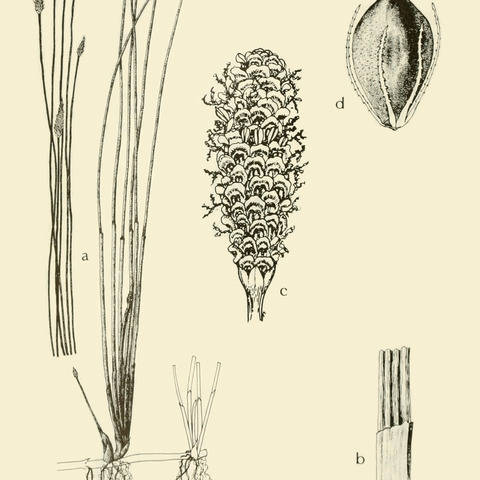Plants perennial, mat-forming; rhizomes evident, long, 1–2 mm thick, firm, cortex persistent, longer internodes 5–10(–20) mm, scales sometimes fugaceous, 5–7 mm, papery (to membranous), sometimes fibrous. Culms terete, often with to 12 blunt ridges when dry, 30–75 cm × 0.5–1.5 mm, firm, internally spongy. Leaves: distal leaf sheaths persistent, not splitting, proximally dark red, distally stramineous or green, papery to membranous, apex dark red brown, obtuse, not callose, tooth rarely present on some culms, 0.2 mm. Spikelets ovoid or subspheric, 5–12 × 2–3(–4) mm, apex acute to obtuse; proximal scale amplexicaulous, entire; subproximal scale with flower; floral scales deciduous, often spreading in fruit, 10–35, 3 per mm of rachilla, red-brown to blackish brown, midrib regions sometimes green, ovate, 2.5–3 × 1.7 mm, apex entire, obtuse to acute, often carinate in distal part of spikelet. Flowers: perianth bristles 1–5, brown, stout, very unequal, rudimentary to equaling achene; stamens unknown [absent from specimens]; styles 3-fid or some 2-fid. Achenes not persistent, dark yellow or medium brown, obovoid to obpyriform, compressed trigonous, or some thickly biconvex, angles evident, 1.1–1.5 × 0.95–1.25 mm, apex rounded, neck very short (to absent), finely rugulose at 10–20X, 20 or more horizontal ridges in vertical series, finely cancellate at 20–30X. Tubercles whitish to brown, pyramidal, not depressed, as high as wide, 0.3–0.5 × 0.4–0.6 mm. 2n = 42.
More
Much like the uniglumate forms of E. palustris, but the achenes prominently punctate-reticulate, often some or most of those on a given plant tricarpellate and obtusely3-angled; culms maroon at the base; 2n=42. Fresh and brackish swamps along the coast; s. Mass. to La. and Tex.; Cuba. (E. ambigens)

